
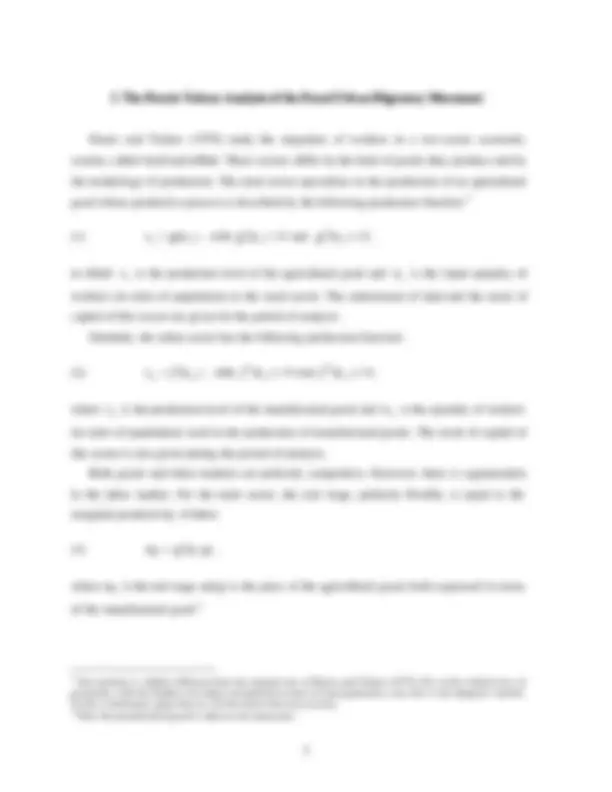
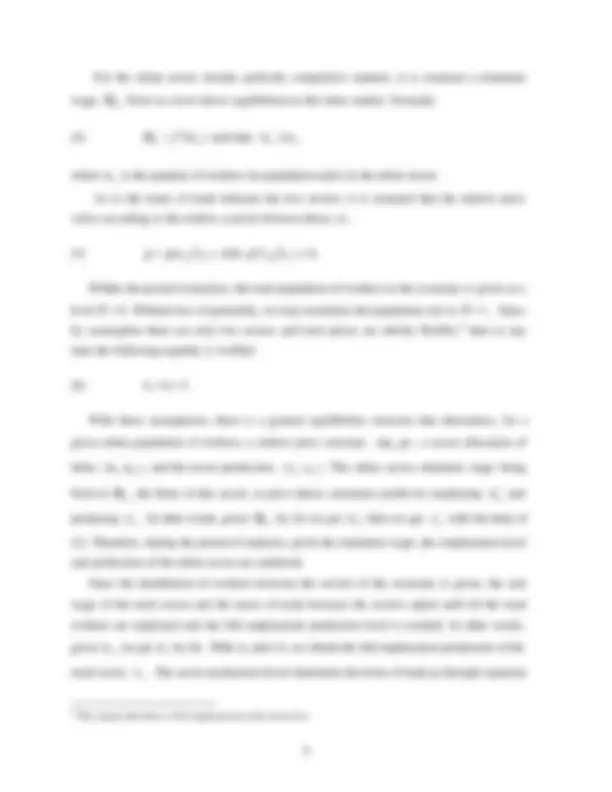
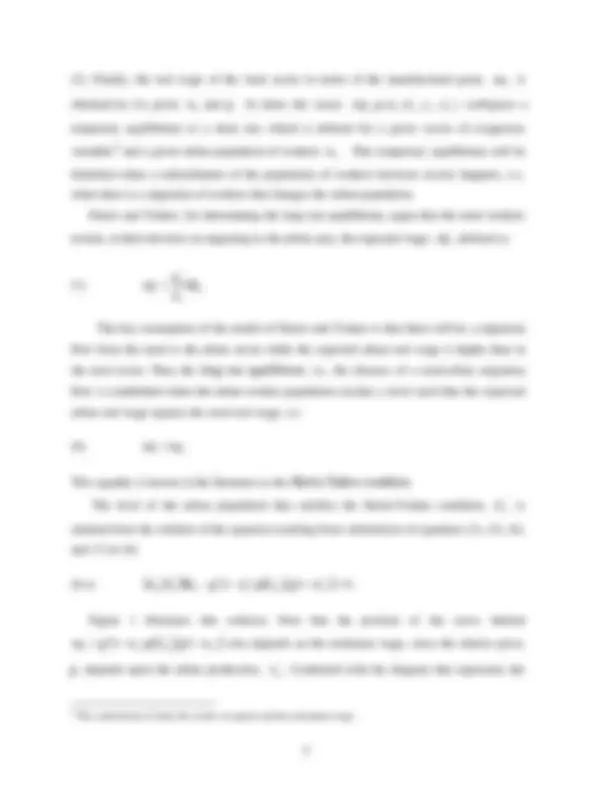
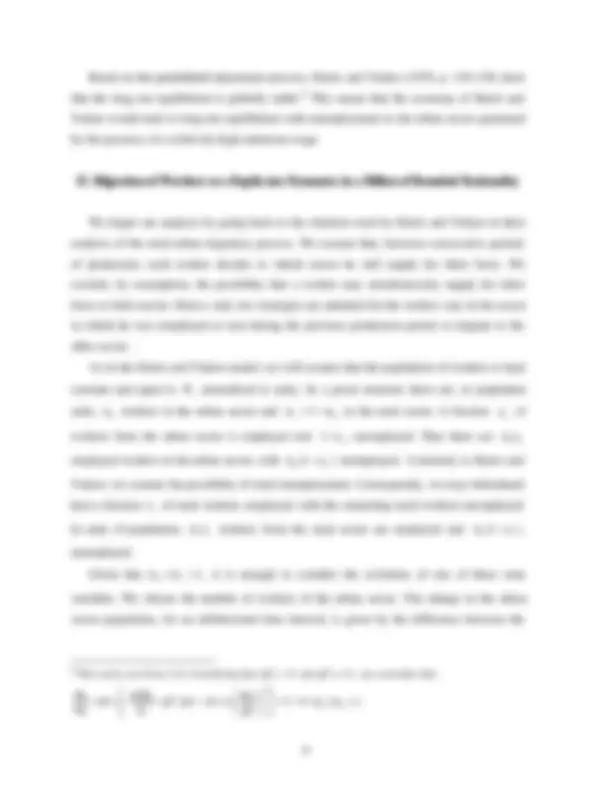
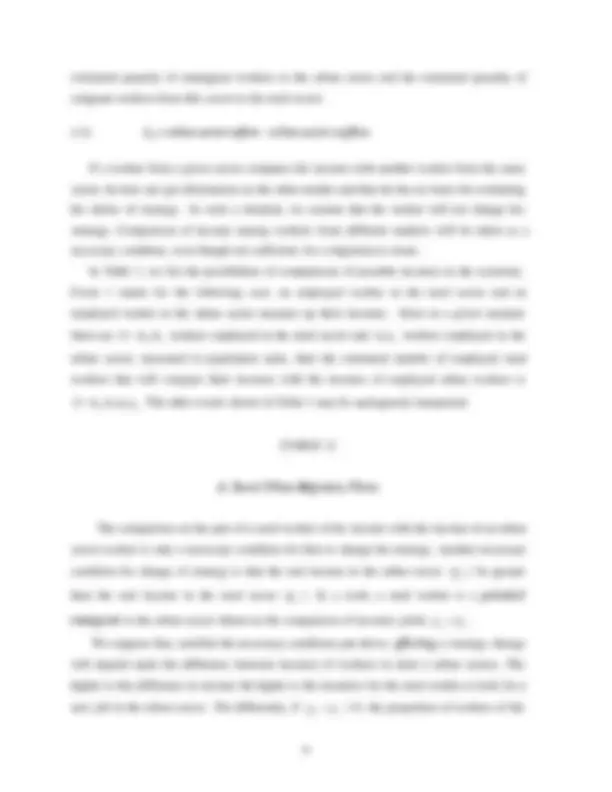
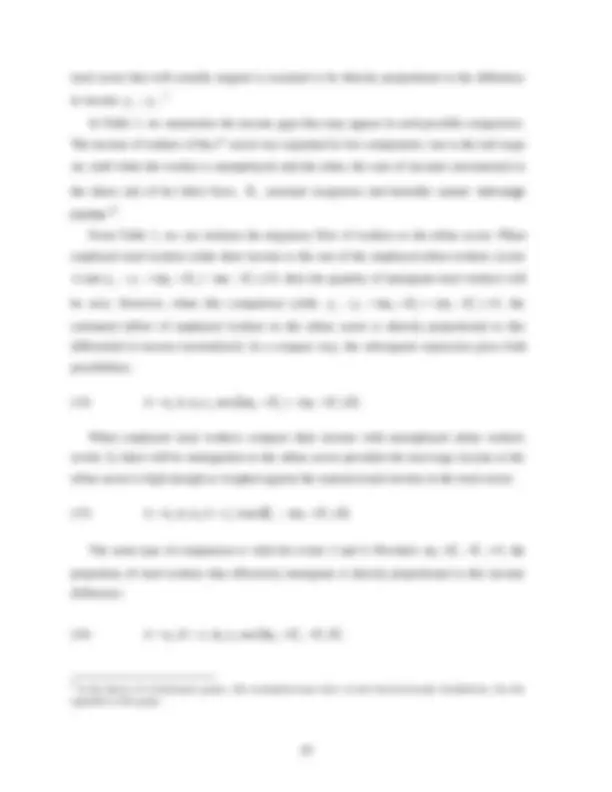
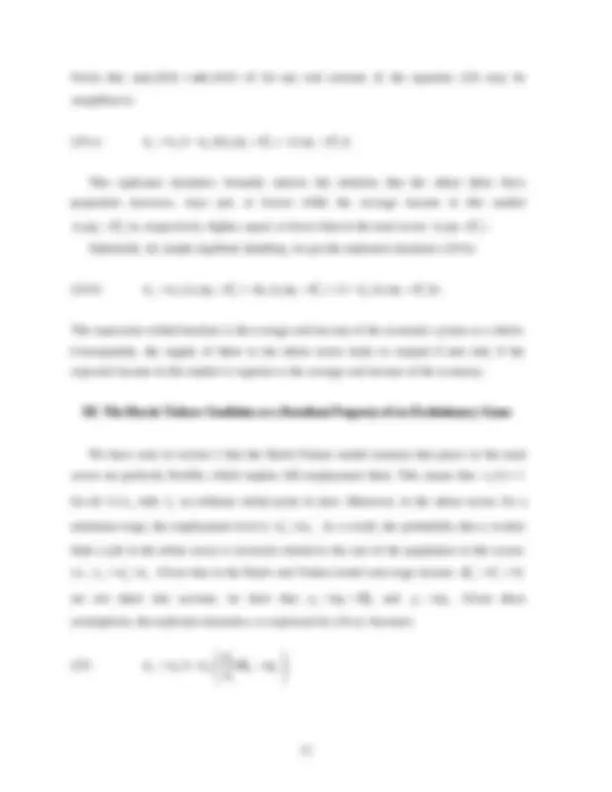
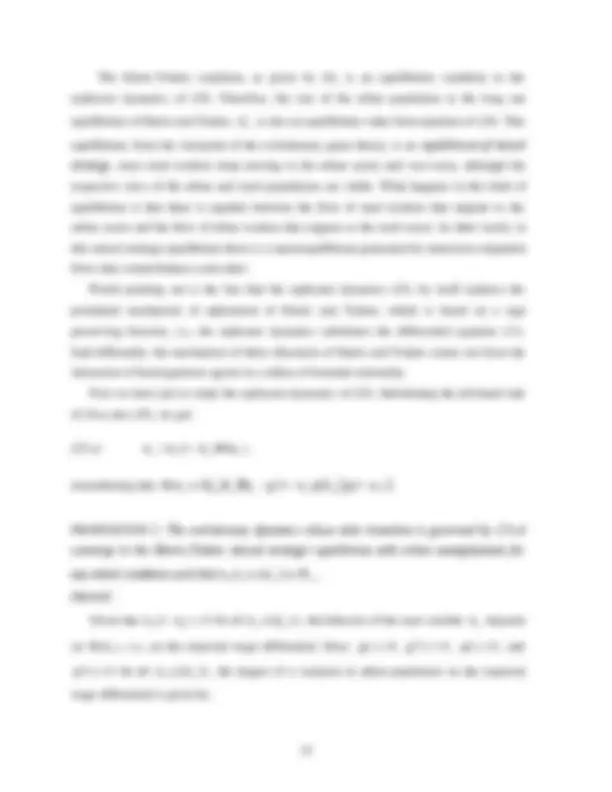
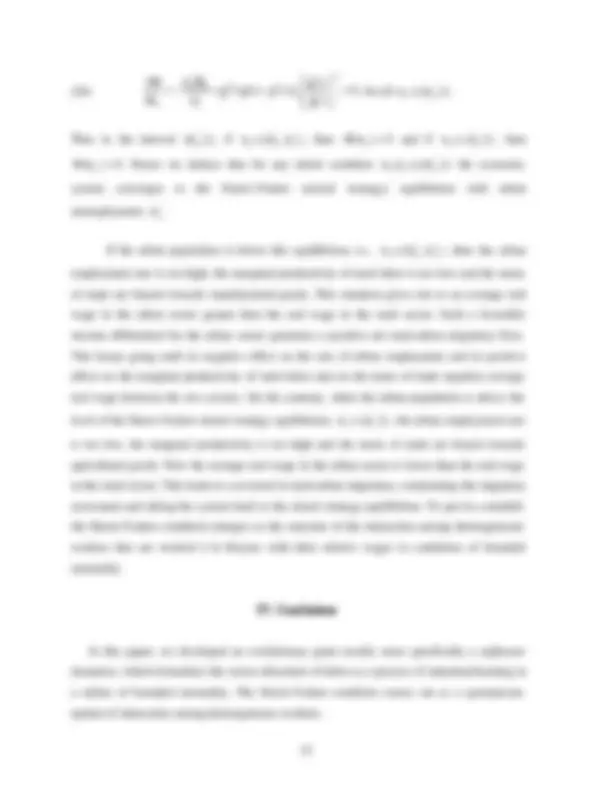
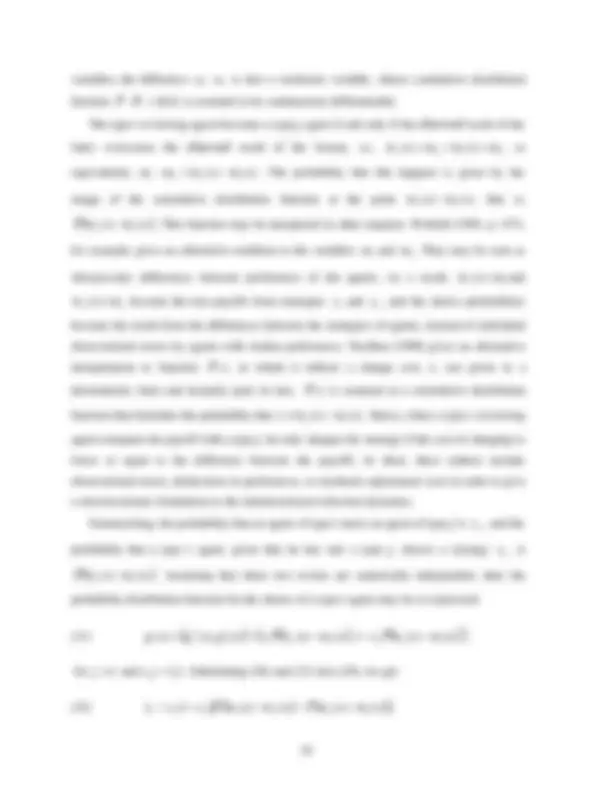
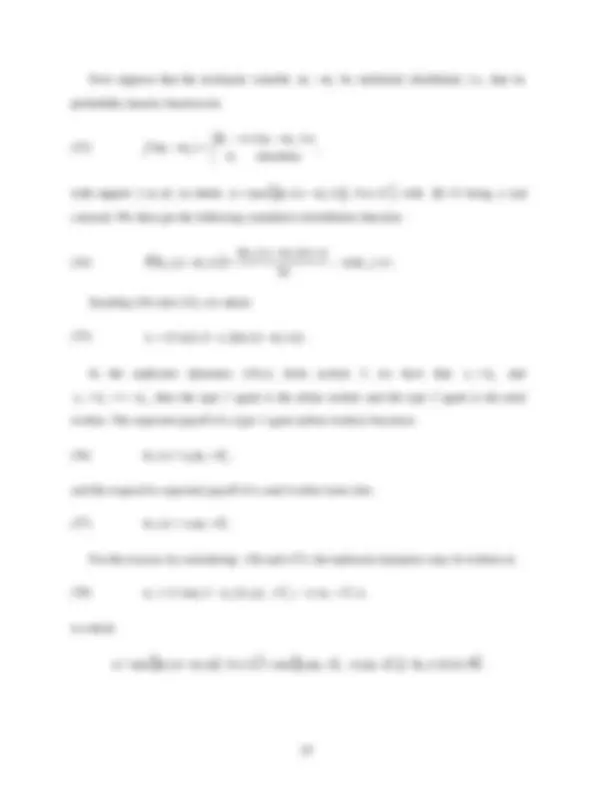
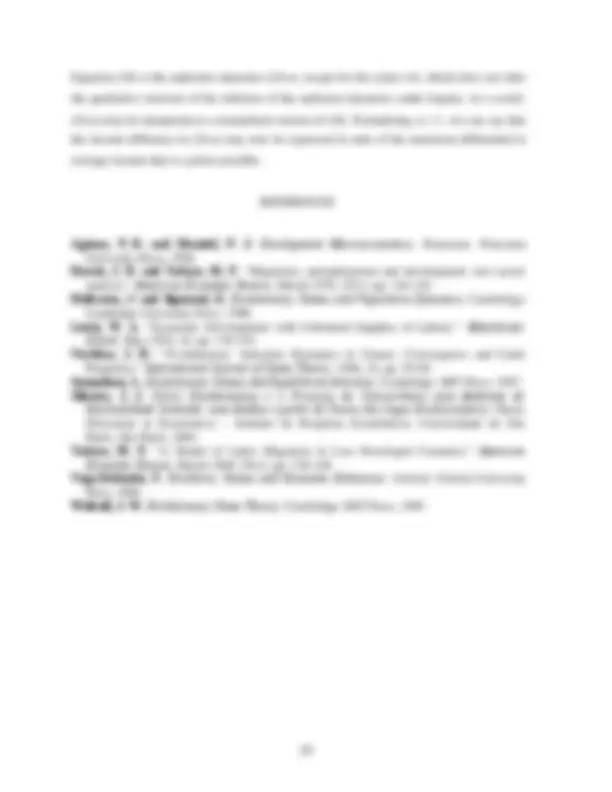
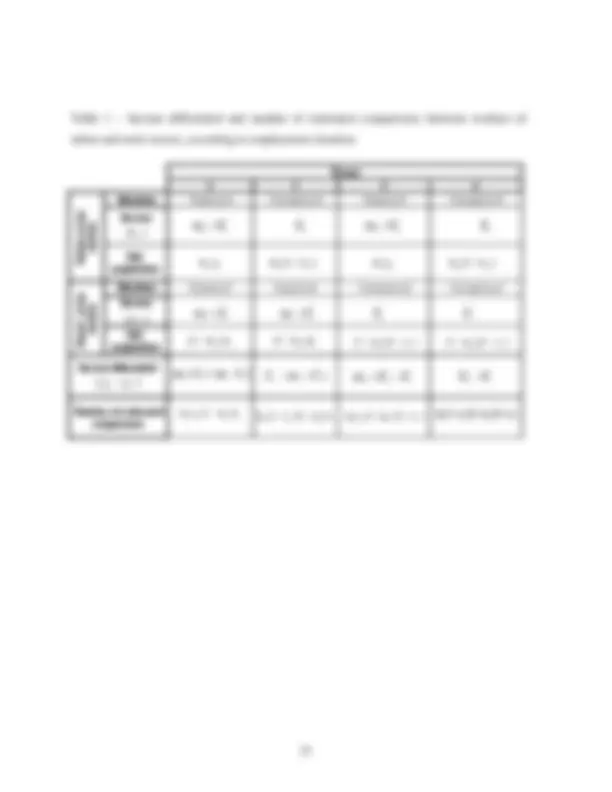
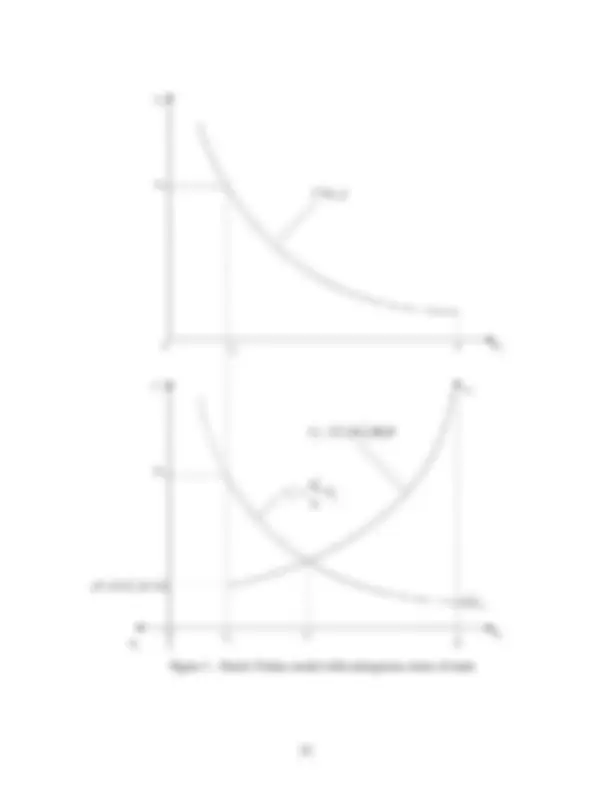


Study with the several resources on Docsity

Earn points by helping other students or get them with a premium plan


Prepare for your exams
Study with the several resources on Docsity

Earn points to download
Earn points by helping other students or get them with a premium plan
Community
Ask the community for help and clear up your study doubts
Discover the best universities in your country according to Docsity users
Free resources
Download our free guides on studying techniques, anxiety management strategies, and thesis advice from Docsity tutors
The Harris-Todaro model, which examines the relationship between urban and rural labor markets, urban employment, and unemployment. The model explores the production function, wage determination, and urban-rural migratory flows. It also introduces the concept of replicator dynamics and its impact on the economic system.
Typology: Study notes
1 / 22

This page cannot be seen from the preview
Don't miss anything!















The Harris-Todaro Labor Allocation Mechanism as an Evolutionary Game By Jaylson Jair da Silveira and João Rogério Sanson*
Abstract The Harris-Todaro model is reinterpreted under an evolutionary game approach, including the behavior of migrants under bounded rationality in a process of imitation or learning. A first feature is an improvement upon Harris-Todaro by replacing the sign-preserving function of the adjustment mechanism by a replicator dynamics, which is deduced from the assumptions about the interaction process among heterogeneous workers in a bounded rationality context. A second feature is an interpretation of the equilibrium condition as a mixed strategy equilibrium of an evolutionary game. The Harris-Todaro equilibrium condition then appears as a spontaneous result of the model.
Key words : migration, labor market, evolutionary game, bounded rationality JEL codes : J6, O15, C
Developing countries generally show some kind of dualism in their labor markets, be it with respect to production structure (traditional and modern), to geographical location (rural and urban), to legal nature of the activities (formal and underground), or to the composition of the labor force (skilled and non-skilled). As shown by Agénor and Montiel (1996, p. 63), duality in the labor market implies a segmentation, i.e., a situation in which identical workers earn different wages depending on where they are employed. Todaro (1969) has built up a seminal model to analyze rural-urban migration in a developing country, extending and formalizing ideas from various authors that followed Lewis (1954). As the main assumption of the model, the decision of the rural worker to migrate depends upon expected differential wage. In Michael Todaro's analysis, the decision to move is seen as an investment decision tied to expected net returns. These expected returns crucially depend upon the probability of getting a job in the modern, or formal, sector versus a job at the traditional urban sector, also called underground or informal. The model takes this
probability as endogenous and influenced by the creation of urban employment and the number of unemployed urban workers. The objective of the model is to show how the employment rate tends to an equilibrium below full employment even in the long run. Harris and Todaro (1970) is a general equilibrium analysis in which the artificial upholding of the wage differential between the rural and urban sectors leads to an inefficient equilibrium. Although the informal sector is now excluded from the model, the concept of expected wage is kept. What determines the expected wage is employment or unemployment in the urban sector. Despite defending the principle that workers take into consideration the present value of the expected real income flow, Todaro (1969) as well as Harris and Todaro (1970) in fact work with the postulate of myopic expectations. Todaro (1969, sect. IV) formally obtains his main conclusions from the assumption that the time horizon of the workers is only one period. Thus, in their model, the differential in real income for time t appears in place of the differential of the present value of the flow of expected real income along two or more periods. This is done in the adjustment mechanism associated with the aggregate supply of workers to the urban sector. Todaro (1969, p. 143, n. 10) justifies this by saying that this "... assumption is made necessary by mathematical convenience but is in fact probably a more realistic formulation in terms of actual decision making in less developed nations ..." [Our italics.] We consider this implicit idea of bounded rationality of the workers, and propose a model based on the tools of the theory of evolutionary games.^1 In our model, the migratory movement of workers is interpreted as a process of imitation/learning in an environment of bounded rationality. 2 With the help of an evolutionary game, we deduce a replicator dynamics that replaces the adjustment mechanism postulated both in Todaro (1969) and Harris and Todaro (1970). Starting with their same general equilibrium structure, but including it in our model of evolutionary game, we show that their classical results appear as a consequence of the interaction among economic agents that try to get higher wages in a context of bounded rationality.
for a young professional research fellowship, developed at the Department of Economics of UFSC. Sanson thanks CNPq for a research grant that included an undergraduate fellowship for Rimenez Tuon. 1 On this theory, see Weibull (1995), Vega-Redondo (1996), Samuelson (1997), and Hofbauer and Sigmund (1998). 2 The model is based on one initially presented in Silveira (2001), where it was used to represent the competition among workers along business cycles.
For the urban sector, besides perfectly competitive markets, it is assumed a minimum wage, ωm , fixed at a level above equilibrium in this labor market. Formally:
(4) ωm = f ′( n * m )such that n (^) m *^ ≤ nu ,
where n (^) u is the quantity of workers (in population units) in the urban sector.
As to the terms of trade between the two sectors, it is assumed that the relative price varies according to the relative scarcity between them, i.e.,
(5) p = ρ ( xm xa ), with ρ ′ ( xm xa )> 0.
Within the period of analysis, the total population of workers in the economy is given at a level n > 0. Without loss of generality, we may normalize the population size to n = 1. Since by assumption there are only two sectors and rural prices are wholly flexible,^5 then at any time the following equality is verified:
(6) na + nu = 1.
With these assumptions, there is a general equilibrium structure that determines, for a given urban population of workers, a relative price structure, ( ωa , p ), a sector allocation of
labor, ( na , nm ), and the sector production, ( xa , xm ). The urban sector minimum wage being
fixed at ωm , the firms of this sector, as price takers, maximize profits by employing n * m and
producing x * m. In other words, given ωm , by (4) we get n * m ; then we get x * m with the help of
(2). Therefore, during the period of analysis, given the minimum wage, the employment level and production of the urban sector are unaltered. Once the distribution of workers between the sectors of the economy is given, the real wage of the rural sector and the terms of trade between the sectors adjust until all the rural workers are employed and the full employment production level is reached. In other words,
given n (^) u , we get na by (6). With n (^) a and (1), we obtain the full employment production of the
rural sector, x (^) a. The sector production levels determine the terms of trade p through equation
(^5) This means that there is full employment in the rural area.
(5). Finally, the real wage of the rural sector in terms of the manufactured good, ωa , is
obtained by (3), given na and p. In short, the vector ( ωa , p , na , n * m , xa , x * m ) configures a
temporary equilibrium or a short run, which is defined for a given vector of exogenous variables^6 and a given urban population of workers n (^) u. This temporary equilibrium will be
disturbed when a redistribution of the population of workers between sectors happens, i.e., when there is a migration of workers that changes the urban population. Harris and Todaro, for determining the long run equilibrium, argue that the rural workers reckon, in their decision on migrating to the urban area, the expected wage, ωeu , defined as:
(7) (^) m u ue m n ω = n^^ * ω.
The key assumption of the model of Harris and Todaro is that there will be a migratory flow from the rural to the urban sector while the expected urban real wage is higher than in the rural sector. Thus, the long run equilibrium , i.e., the absence of a rural-urban migratory flow is established when the urban worker population reaches a level such that the expected urban real wage equates the rural real wage, i.e.:
(8) ωue = ωa.
This equality is known in the literature as the Harris-Todaro condition. The level of the urban population that satisfies the Harris-Todaro condition, n * u , is
attained from the solution of the equation resulting from substitution of equations (3), (5), (6), and (7) in (8):
Figure 1 illustrates this solution. Note that the position of the curve labeled
p , depends upon the urban production, x * m. Combined with the diagram that represents the
(^6) The endowment of land, the stocks of capital and the minimum wage.
value theorem and conclude that there is some n (^) u n * m , (^1 2) ⊂[ n m *, 1 )
∗ (^) ∈^ − δ^ such that Φ( n u ∗)= 0.
Moreover, considering (1), (2) and (5) we have
() () () (()) 0
2
g g x g n
n n (^) u m
m m u
ω (^) ρ ρ for all n (^) u ∈[ n m *, 1 ).
Hence, since ∂ n u
∂ Φ is continuous in interval [ *, 1 ) n m , there is only one nu ∗^ ∈[ n * m , 1 ) such that
Φ ( n u ∗)= 0.
By condition (9), as the numbers of rural workers tend to zero, both the labor productivity in this sector and the terms of trade tend to extreme high values. Thus the rural real wage becomes greater than the expected urban real wage. On its part, condition (10) establishes that, at the value for which the minimum wage restriction is binding, the real rural wage must be smaller than the expected urban real wage, which in the present case equals the exogenously determined minimum wage. Harris and Todaro (1970, p. 129), in order to evaluate the long run equilibrium, postulate a mechanism of adjustment that is based on the following function of sign preservation:
(11) n & (^) u = ψ ( ωue − ωa ), with ψ ′ ( ⋅)> 0 and ψ ( 0 )= 0.
Thus, while ωu e > ωa , n &^ u > 0 will be the result, and only if ωue = ωa , n & u^ = 0 will occur. The
differential equation that governs the state transition in the model of Harris and Todaro is obtained by substituting the left-hand side of (8-a) in (11):
It should be stressed that the state space for (11) is the real interval [ n m *, 1 ), which is positively
invariant.^7
(^7) Considering (10) in n (^) u = n * m , this results in n & u (^) > 0. Given condition (9) and the fact that
Based on this postulated adjustment process, Harris and Todaro (1970, p. 138-139) show that the long run equilibrium is globally stable.^8 This means that the economy of Harris and Todaro would tend to long run equilibrium with unemployment in the urban sector generated by the presence of a relatively high minimum wage.
II. Migration of Workers as a Replicator Dynamics in a Milieu of Bounded Rationality
We begin our analysis by going back to the situation used by Harris and Todaro in their analysis of the rural-urban migratory process. We assume that, between consecutive periods of production, each worker decides to which sector he will supply his labor force. We exclude, by assumption, the possibility that a worker may simultaneously supply his labor force to both sectors. Hence, only two strategies are admitted for the worker: stay in the sector in which he was (employed or not) during the previous production period or migrate to the other sector. As in the Harris and Todaro model, we will assume that the population of workers is kept
constant and equal to n , normalized to unity. In a given moment, there are, in population units, nu workers in the urban sector and n (^) r = 1 − nu , in the rural sector. A fraction vu of
workers from the urban sector is employed and 1 − vu , unemployed. Thus there are nu vu
employed workers in the urban sector, with nu ( 1 − vu ) unemployed. Contrarily to Harris and
Todaro, we assume the possibility of rural unemployment. Consequently, we may beforehand have a fraction v (^) r of rural workers employed, with the remaining rural workers unemployed.
In units of population, n (^) r vr workers from the rural sector are employed and n (^) r ( 1 − vr ),
unemployed. Given that n (^) u + nr = 1 , it is enough to consider the evolution of one of these state
variables. We choose the number of workers of the urban sector. The change in the urban sector population, for an infinitesimal time interval, is given by the difference between the
(^8) This can be seen from (12). Considering that ψ ′ ( ⋅)> 0 and g ′′( ⋅)< 0 , one concludes that:
() () () () (()) 0 *^2 2
⋅ = ′⋅ − + ′′⋅ ⋅ − ′⋅ ′⋅ ∂
∂ g g x g n
n n
n (^) m u
m m u
& (^) u (^) ψ ω ρ ρ , for (^) n * m (^) ≤ nu < 1.
rural sector that will actually migrate is assumed to be directly proportional to the difference in income yu − yr.^9
In Table 1, we summarize the income gaps that may appear in each possible comparison. The income of workers of the ith^ sector was separated in two components: one is the real wage ω i (null when the worker is unemployed) and the other, the sum of incomes unconnected to
the direct sale of his labor force, εi , assumed exogenous and hereafter named non-wage
income.^10 From Table 1, we can estimate the migratory flow of workers to the urban sector. When employed rural workers relate their income to the one of the employed urban workers (event
be zero. However, when this comparison yields yu − yr =( ω (^) u + εu )−( ωr − εr )> 0 , the
estimated inflow of employed workers in the urban sector is directly proportional to this differential in income (normalized). In a compact way, the subsequent expression gives both possibilities:
(14) ( 1 − nu ) vrnuvu max{( ωu + εu )−( ωr + εr ), 0 }.
When employed rural workers compare their income with unemployed urban workers (event 2), there will be immigration to the urban sector provided the non-wage income at the urban sector is high enough as weighed against the expected total income in the rural sector:
(15) ( 1 − nu ) vrnu ( 1 − vu )max{ ε (^) u −( ωr + εr ), 0 }.
The same type of comparison is valid for events 3 and 4. Provided ωu + εu − εr > 0 , the
proportion of rural workers that effectively immigrate is directly proportional to this income difference:
(16) ( 1 − nu )( 1 − vr ) nuvu max{ ω (^) u + εu − εr , 0 }.
(^9) In the theory of evolutionary games, this assumption may have several microeconomic foundations. See the appendix to this paper.
Likewise, an encounter of unemployed rural workers with unemployed urban workers, combined with appropriate differential in incomes will result in an inflow of workers to the urban sector given by
(17) ( 1 − nu )( 1 − vr ) nu ( 1 − vu )max{ ε (^) u − εr , 0 }.
By aggregating expressions (14), (15), 16) and (17), we get the expected migratory flow from the rural to the urban sector:
r u u u r r u u r
u u r u u u r r r u u r r v v v v
n n vv v v ω ε ε ε ε
ω ε ω ε ε ω ε
B. Urban-Rural Migratory Flows
A worker from the urban sector becomes a potential emigrant only if he compares his income with the income of a worker from the rural sector and discovers that yr = ωr + εr > ωu + εu = y u. As before, four events are possible in this pairwise comparison
of incomes, according to the situation of employment of each worker in the urban and the rural sectors. Take, for example, event 1. As employed urban workers contrast their income with the income of their equals as to the employment situation in the rural area, two results are possible. If y (^) u − yr = ωu + εu −( ω (^) r + εr )≥ 0 , no employed urban worker leaves his area.
However, if y (^) u − yr = ωu + εu −( ω (^) r + εr )< 0 , the migratory outflow from the urban area will be directly proportional to this difference in income, or:
(19) − nu vu ( 1 − nu ) vr min{ ωu + εu −( ωr + εr ), 0 }.
(^10) The non-wage income may be generalized to include net benefits of the public budget plus other usual sources of income that are studied in the literature on migration. Thus, even under unemployment in both areas, it may be worth the effort to migrate to the urban sector.
Given that max{ d , 0 }+ min{ d , 0 }= d for any real constant d , the equation (24) may be
simplified to:
(24-a) n &^ u = nu ( 1 − nu )[( vuωu + εu )−( vrωr + εr )].
This replicator dynamics formally mirrors the intuition that the urban labor force proportion increases, stays put, or lowers while the average income in this market
( vu ωu + εu )is, respectively, higher, equal, or lower than in the rural sector ( vr ωr + εr ). Optionally, by simple algebraic handling, we get the replicator dynamics (24-b):
(24-b) n & (^) u = nu {( vuωu + εu )−[ nu ( vuωu + εu )+( 1 − nu )( vrωr + εr )]}.
The expression within brackets is the average real income of the economic system as a whole. Consequently, the supply of labor to the urban sector tends to expand if and only if the expected income in this market is superior to the average real income of the economy.
III. The Harris-Todaro Condition as a Resultant Property of an Evolutionary Game
We have seen in section 2 that the Harris-Todaro model assumes that prices in the rural sector are perfectly flexible, which implies full employment there. This means that vr ( t )= 1
for all t ≥ t 0 , with t (^) 0 an arbitrary initial point in time. Moreover, in the urban sector, for a
minimum wage, the employment level is n (^) m *^ ≤ nu. As a result, the probability that a worker
finds a job in the urban sector is inversely related to the size of the population in this sector,
i.e., v (^) u = nm */ nu. Given that in the Harris and Todaro model non-wage income ( εu = εr = 0 )
are not taken into account, we have that y (^) u = ωu = ωm and y (^) r = ωa. Given these
assumptions, the replicator dynamics, as expressed by (24-a), becomes:
u u u nmu m a n &^ n ( 1 n ) n^ * ω ω.
The Harris-Todaro condition, as given by (8), is an equilibrium condition in the replicator dynamics of (25). Therefore, the size of the urban population at the long run equilibrium of Harris and Todaro, n * u , is also an equilibrium value from equation of (25). This
equilibrium, from the viewpoint of the evolutionary game theory, is an equilibrium of mixed strategy , since rural workers keep moving to the urban sector and vice-versa, although the respective sizes of the urban and rural populations are stable. What happens in this kind of equilibrium is that there is equality between the flow of rural workers that migrate to the urban sector and the flow of urban workers that migrate to the rural sector. In other words, in this mixed strategy equilibrium there is a macroequilibrium generated by intersector migration flows that counterbalance each other. Worth pointing out is the fact that the replicator dynamics (25), by itself replaces the postulated mechanism of adjustment of Harris and Todaro, which is based on a sign preserving function, i.e., the replicator dynamics substitutes the differential equation (11). Said differently, the mechanism of labor allocation of Harris and Todaro comes out from the interaction of heterogeneous agents in a milieu of bounded rationality. Now we have just to study the replicator dynamics of (25). Substituting the left-hand side of (8-a) into (25), we get:
(25-a) n &^ u = nu ( 1 − nu )Φ( nu ),
PROPOSITION 2: The evolutionary dynamics whose state transition is governed by (25-a) converge to the Harris-Todaro (mixed strategy) equilibrium with urban unemployment for
any initial condition such that n (^) u ( t 0 )∈ [ n * m , 1 )∈ℜ++.
PROOF:
Given that n (^) u ( 1 − nu )> 0 for all n (^) u ∈ [ n * m , 1 ), the behavior of the state variable nu depends
on Φ ( nu ), i.e., on the expected wage differential. Since g ( ⋅)> 0 , g ′′( ⋅)< 0 , ρ ( ⋅)> 0 , and
ρ ′ ( ⋅)> 0 for all n (^) u ∈[ n * m , 1 ), the impact of a variation in urban population on the expected
wage differential is given by:
In the model we propose here, due to the separation of income in two parts – wage and non-wage income – there is room for studying the role of public policies that influence the non-wage component of income and therefore influence the migratory dynamics of Harris and Todaro. Analyzing this dynamics is directly relevant to a better understanding of the process of urban concentration.
APPENDIX:
AN ALTERNATIVE DERIVATION OF THE REPLICATOR DYNAMICS (24-A): The evolutionary game models based on an imitation process are formed by two essential pieces as highlighted by Weibull (1995, p. 152): "the time rate at which agents review their strategy choice" and "the choice probabilities of a reviewing agent." Let xi be the proportion
of individuals from the population that opt for the strategy si ( type i agents ), among h possible strategies and x = ( x 1 , x 2 ,K, xi ,K, xh )be the distribution of strategies in the population. The
(average) rate of revision of a type i agent refers to the average number of times this agent revises his strategy per time interval, and may be taken as function of the state of the population, ri ( x ). This rate of revision may be considered as an arrival rate of a Poisson
process, i.e., a realization of Poisson process. Let us assume that the frequency with which an agent reconsiders his strategy in a given time interval does not affect the frequency of revisions of the other agents, which is the same as saying that the Poisson process of individual revisions are statistically independent. We then conclude that the aggregate rate of revision of the subpopulation given by type i agents is by itself a Poisson process with an
average rate of revision x (^) i ri ( x ). If changes in individual strategies are statistically
independent random variables, then the flow of agents from the type i subpopulation to the
type j subpopulation is an aggregate Poisson process with the arrival rate x (^) i ri ( x ) pij ( x ), where
p (^) ij ( x )is the probability of a type i agent becoming a type j. The choice probabilities of a type
naturally with ( ) 1 1 ∑^ = =
h j
p (^) ij x.
In the case of only two possible strategies, h = 2 , we have x 1 (^) + x 2 = 1. Thus we need to
consider only one state variable. Without loss of generality, we will take x 1 as the reference
state variable, so the vector of distribution of strategies will be perfectly determined once x 1
is given, because x = ( x 1 , x 2 )=( x 1 , 1 − x 1 ). The inflow to the subpopulation of type i agents
can be approximated by
(27) x 2 r 2 ( x ) p^12 ( x )
and the outflow by
(28) x 1 (^) r 1 ( x ) p 12 ( x ).
The rate of variation of subpopulation 1 will be determined by the difference between inflow and outflow:
(29) x & 1 = x 2 r 2 ( x ) p^12 ( x )− x 1 r 1 ( x ) p 12 ( x ).
As explained by Weibull (1995, sect. 4), there are several assumptions pertaining to the revision rate and to the probability of choice that may be adopted. In section 3 above, we implicitly assumed that all reviewing agents reassess their choice together and just once per time interval, or
(30) r 1 ( x )= r 2 ( x )= 1
As in section 3, we assume a direct imitation process (Weibull, 1995, p. 155-158), i.e., each reviewing agent randomly meets another agent so that the probability of a reviewing agent encountering an agent that follows strategy s 1 is x 1 and one that follows s 2 is
x (^) 2 = 1 − x 1. As done by Weibull (1995, p. 155-158), we suppose that, after the reviewing
agent meets another agent, he detects, with some noise, his own payoff, 11 π (^) i ( x )+ αi , and the
payoff linked to the strategy of the other agent, π (^) j ( x )+ αj. Since αi and α (^) j are stochastic
(^11) πi ( x ) is the expected result for an agent that opts for a strategy si when the population state is x = ( x 1 , x 2 )=( x 1 , 1 − x 1 ).
Now suppose that the stochastic variable αi − αj be uniformly distributed, i.e., that its
probability density function be:
0 , elsewhere f ( ) , a i j a i j α α β α^ α ,
constant. We then get the following cumulative distribution function:
Inserting (34) into (32), we attain:
(35) x & 1 (^) =( 1 / a ) x 1 ( 1 − x 1 )[ π 1 ( x )− π 2 ( x )].
In the replicator dynamics (24-a), from section 3, we have that x (^) 1 = nu and x (^) 2 = nr = 1 − n u , thus the type 1 agent is the urban worker and the type 2 agent is the rural
worker. The expected payoff of a type 1 agent (urban worker) becomes:
(36) π (^) 1 ( x )= vuωu + εu ,
and the respective expected payoff of a rural worker turns into:
(37) π (^) 2 ( x )= vrωr + εr.
For this reason, by considering (36) and (37), the replicator dynamics may be written as:
(38) n & (^) u =( 1 / a ) nu ( 1 − nu )[( vuω (^) u + εu )−( vrωr + εr )],
in which
Equation (38) is the replicator dynamics (24-a), except for the scalar 1/ a , which does not alter the qualitative structure of the solutions of the replicator dynamics under inquiry. As a result, (24-a) may be interpreted as a normalized version of (38). Normalizing a = 1 , we can say that the income difference in (24-a) may now be expressed in units of the maximum differential in average income that is a priori possible.
REFERENCES
Agénor, P.-R. and Montiel, P. J. Development Macroeconomics. Princeton: Princeton University Press, 1996. Harris, J. R. and Todaro, M. P. “Migration, unemployment and development: two sector analysis.” American Economic Review , March 1970, 15 (1), pp. 126-142. Hofbauer, J. and Sigmund, K. Evolutionary Games and Population Dynamics. Cambridge: Cambridge University Press, 1998. Lewis, W. A. “Economic Development with Unlimited Supplies of Labour.” Manchester School , May 1954, 22, pp. 139-191. Nachbar, J. H. “‘Evolutionary’ Selection Dynamics in Games: Convergence and Limit Properties.” International Journal of Game Theory , 1990, 19, pp. 59-89. Samuelson, L. Evolutionary Games and Equilibrium Selection. Cambridge: MIT Press, 1997. Silveira, J. J. Ciclos Goodwinianos e o Processo de Concorrência num Ambiente de Racionalidade Limitada: uma Análise a partir da Teoria dos Jogos Evolucionários. Thesis (Doctorate in Economics) – Instituto de Pesquisas Econômicas, Universidade de São Paulo, São Paulo, 2001. Todaro, M. P. “A Model of Labor Migration in Less Developed Countries.” American Economic Review , March 1969, 59(1), pp. 138-148. Vega-Redondo, F. Evolution, Games and Economic Behaviour. Oxford: Oxford University Press, 1996. Weibull, J. W. Evolutionary Game Theory. Cambridge: MIT Press, 1995.